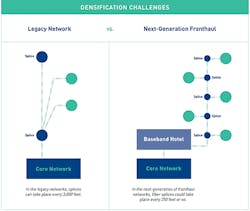Fiber, Street Furniture, Buildings, Power, and Collaboration —
As more people embrace the mobile-first society, wireless carriers have had to use a combination of more spectrum, new network technologies and densification efforts to bring added network capacity and coverage for their customers, including deploying more Distributed Antenna Systems (DAS) and small cells to bring the network closer to the end user. It’s important to note that DAS networks (along with other wireless applications and access technologies) are a complementary solution to macrocellular sites, and not a replacement.
Over the last decade, economic, regulatory, and operational, concerns have prompted wireless carriers to look for complementary wireless technologies and solutions that would reduce their need to deploy macrocellular sites and installations on towers. With each technological advance in wireless radio networks, however, subscriber growth, changes in user behavior and user expectations have only increased the need for more macro sites deployed on towers and rooftops. Smart communities will need more wireless connectivity, as well as a robust fiber foundation, to match the smart community vision with reality.
Fiber
A fiber backbone is a key foundational component of any smart community. While fiber networks span the globe, connecting communities that are continents apart, the scope of fiber networks addressed within this report include metro fiber and dark fiber. That will address the need for further densification of fiber networks within communities to support the higher number of wireless network access points, wireless devices and end users.
Fiber networks enable a myriad of smart-community solutions. Wireline fiber networks provide high-speed broadband services used by educational institutions, public-safety officials and hospitals. Whether a device is connected via licensed spectrum or unlicensed spectrum, fiber networks play a critical role as the backhaul network for all mobile, fixed-wireless and other forms of wireless networking. According to Cisco’s 2017 Visual Network Index Forecast, wireline networks support nearly 90 percent of all Internet traffic, the majority of which is generated by wireless devices.1 Today, smartphones account for a large source of wireless-originated Internet traffic, but the adoption of IoT devices will only increase wireless- originated traffic.
As wireless traffic continues to grow, additional fiber network infrastructure must be deployed to meet the projected demand. A 2017 report by Deloitte Consulting LLP states that "Unlocking the full potential of 5G in the United States rests on one key assumption: the extension of fiber deep into the network." 5G promises higher mobile data rate speeds, including several hundreds of Megabits per second (Mbps) in urban environments and 1 Gigabit per second (Gbps) or higher in indoor environments, all of which will require supporting fiber networks that can meet capacity increases as wireless traffic grows. Without additional fiber network infrastructure deployments that reach deeper into metropolitan centers and edge communities, Deloitte’s report also asserts that "carriers will be unable to support the projected four-fold increases in mobile data traffic between 2016 and 2021."2
Due to the increase in wireless traffic, dark fiber network operators, or operators that deploy high-capacity fiber networks and then lease capacity (in the form of number of fiber strands) to customers ranging from enterprises to mobile network operators, have become significantly important to addressing wireless traffic growth. These fiber networks are only activated — or lit — when their customers need increased bandwidth.
Legacy fiber backhaul networks are typically built with relatively low fiber capacity that is heavily multiplexed with dense accessibility (e.g., fiber-to-the-home networks), or high fiber capacity and sparse accessibility (e.g., enterprise fiber networks). Also, backhaul networks in a typical dense urban environment are designed for lateral splice locations every few thousand feet. (See Figure 1.)
Figure 1. Source: Ra LaChance, ZenFi
To obviate the limitations of legacy networks, a new fronthaul access network must be architected differently, with high fiber capacity as well as easy accessibility, allowing for lateral splices every few hundred feet or less. Such a fronthaul network must also provide relatively short links to interconnect the baseband processing to the distributed RF interface locations to meet stringent latency requirements. The new fronthaul network architecture primarily differs from legacy backhaul architectures due to the density of fiber lateral splice points necessary and the number of dedicated fibers required to serve each end point.
To visualize the difference between backhaul topology and the front network topology, think of the backhaul network as an expressway with sparsely spaced on-ramps and the fronthaul network as the local roadways with a collocation facility acting as the interface between the 2 network topologies. A "Network of Neighborhood Networks" model offers an analogy with the legacy central office topology where large voice switches are replaced with baseband processing cloud equipment and the 2,400 pair copper trunks are replaced with 1,728 or greater fiber optic cables (3,456 fiber cables are shipping today).
Similar to legacy copper plant, the fiber network must taper down as it becomes an access network and routes along the neighborhood streets, providing accessibility everywhere along its path. However, unlike the copper plant, which is more easily intercepted and spliced into, to enable the new network model, innovative techniques for ducts, cables and fiber splicing must be developed to support the unique nature of fronthaul access topology.
Street-Level Wireless Infrastructure
Street furniture is a term used to define vertical objects in public spaces that — in the context of wireless infrastructure — can accommodate an antenna, radio equipment, and/or other sensor equipment, and are considered visually commonplace and acceptable to the public. Street furniture to be used for this purpose must have a power source and fiber connectivity for the wireless equipment to function. Common examples of street furniture outfitted for wireless networks include billboards, lamp posts, kiosks, phone booths, mailboxes, park benches, public art, utility poles, athletic field light poles, traffic signals, retrofitted bus-stop stations, and other structures, in the public right-of-way.
Good design and engineering is crucial to successful small-cell deployments on street furniture. The aesthetic features of street furniture installations must be carefully considered and worked out with local jurisdictions and townships. In a future world of many small cells and thousands of IoT sensors installed all over urban areas, it is conceivable that each major intersection could be inundated with many street furniture installations. Therefore, concealed and stealth-type designs that do not unreasonably increase the cost of deployment could be a design option.
Utility Pole Attachments: These are often desired street-level furniture for wireless infrastructure for the following reasons:
• Where local utility service is provided via overhead pathways, utility poles are often well- positioned to serve as wireless infrastructure installation sites. The number of sites available provides design flexibility and antenna attachments at appropriate heights.
• Utility pole owners typically understand joint-usage rules and have existing processes that new parties attaching to their poles can follow to reduce the deployment timeline.
• The utility pole infrastructure likely already contains power service and backhaul pathways, both of which are needed for small-cell deployments.
Smart Poles: In some cases, new poles can be effective in providing wireless coverage. When integrated into the network deployment strategy from the start, these "smart" poles can be designed as structures that blend into the environment. They may carry the required telecommunication equipment internally inside the pole and provide opportunities for new technologies offered in the future. Examples include smart poles that are designed to offer more energy conservation through LED lighting, reducing energy and maintenance expenditures while providing broadband connectivity to residents.
InvisiLight® Solution for Deploying Fiber
April 2, 2022Go to Market Faster. Speed up Network Deployment
April 2, 2022Episode 10: Fiber Optic Closure Specs Explained…
April 1, 2022Food for Thought from Our 2022 ICT Visionaries
April 1, 2022Infrastructure Collocation
To support small cell speed-to-market efforts, operators deploying wireless technology on public rights of way or existing private structures can work with infrastructure partners that offer already-approved sites from a permitting, fiber and power perspective.
Timely access to these types of qualified sites and assets makes it quicker and easier to find locations to deliver wireless solutions to users and enable smart cities. It also shortens the time spent negotiating with multiple structure owners, and reduces the effort required to secure the necessary permissions and approvals.
Local jurisdictions should make their infrastructure, including street furniture, available for collocation (the shared use of wireless infrastructure by multiple carriers) to reduce visual clutter and avoid unnecessary duplication of infrastructure.
Collocation is today’s industry norm, and it works well both for the industry and for communities. The practice of sharing infrastructure offers an ordered and transparent process for all industry players.
This streamlined approach helps level the playing field while also lowering barriers for new entrants, encouraging competition in support of increased innovation. Shared wireless infrastructure minimizes the need for infrastructure, which is a practice that is supported by the environmental, historic, and cultural preservation communities.
Cities should encourage locating wireless communication facilities on existing structures to reduce the number of new communication structures needed to serve their communities. An antenna that is attached to an existing building with any accompanying pole or device that anchors the antenna and/or radio to the existing building along with associated connection cables and an equipment facility (which may be located either inside or outside the existing building) usually supports a streamlined and expedited permitting process.
The use of stealth technology that disguises wireless communication facilities to fit into the natural or urban landscape will also benefit in a streamlined deployment process. Furthermore, to solidify a favorable permitting process, proposed small cell deployments should be designed and sited to complement urban residential areas, as well as historic and scenic corridors, and not impact the city’s current and future beautification conditions.
Power Requirements of Infrastructure: For pole infrastructure and street furniture to be part of a carrier’s wireless network, it must have power and the ability to backhaul traffic, meaning that it distributes the RF signal from the edge of the network back to the operator’s core network. Some carriers also require back- up power sources. Back-up power requirements largely have been set by network providers and vary from small solar-powered solutions to a centralized Direct Current (DC) power hub.
Buildings: Small cells and IoT sensors typically do not require as much height as macro sites. Therefore, shorter buildings can be ideal locations for installation of these types of equipment. Building rooftops and exterior facades can be integrated into the deployment of smart city networks. Today, most buildings in urban cities have fiber installed to serve enterprise or residential tenants’ needs for high bandwidths and Internet services and are equipped with adequate power to host telecom installations.
Educating the building managers and owners on the appropriate expectations for these smaller installations will be key to making these existing locations available for such deployments. Appropriate construction methods must be used to avoid damaging the rooftops or the facades of these buildings and causing problems for property owners and managers.
Conclusion
Smart cities and communities are quickly becoming a reality as municipalities look to provide enhanced public-safety services, sustainability, and efficiency within transportation, energy, water, waste, and other public services. Broadband connectivity is crucial for cities and communities, both rural and urban, to remain financially healthy and to provide citizens with educational and other opportunities.
These advances will require not only an expansion and densification of wireless networks that serve end users and accomplish connectivity among devices and sensors, but also of the fiber networks that backhaul an increasing amount of wireless data and traffic. Communities should adopt a forward-thinking and cooperative approach to accommodating infrastructure elements in public rights of way and on existing utility and other structures.
Endnotes
1. Cisco’s 2017 Visual Network Index Forecast
2. Deloitte Study: 5G Ready — The Need for Dark Fiber
For more information, please visit https://wia.org/resource-library/wireless-infrastructure-as-the-foundation-of-smart-cities-and-communities/. For more information, please email [email protected] or visit www.wia.org. Follow the WIA on Twitter: @WIAorg.









